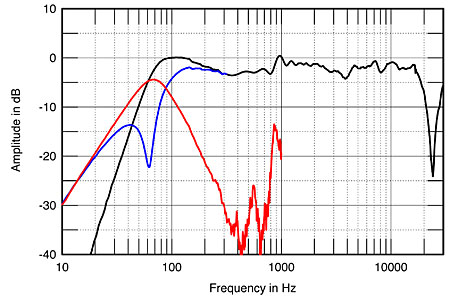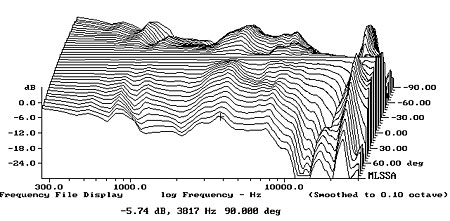| Columns Retired Columns & Blogs |
Sonics Anima loudspeaker Measurements
Sidebar 3: Measurements
Footnote 1: Reviewed by Jack English for Stereophile in October 1994.
The little Sonics by Joachim Gerhard Anima is of slightly below-average voltage sensitivity, at an estimated 85dB(B)/2.83V/m. Its impedance varies around an average of 8 ohms in the midrange and bass, but falls to a minimum of 3.6 ohms in the mid-treble (fig.1). As a result, it might sound a little more laid-back with tube amplifiers having a high source impedance than it will with typical solid-state amps. The electrical phase angle is generally modest, so the Anima should be fairly easy to drive.

Fig.1 Sonics Anima, electrical impedance (solid) and phase (dashed). (2 ohms/vertical div.)
The traces in fig.1 are free from the small discontinuities that would indicate the presence of cabinet panel resonances. Investigating the vibrational behavior of the various surfaces with a plastic-tape accelerometer turned up a low-level resonant mode at 535Hz on the cabinet top (fig.2) and another, at 880Hz, on the side panel (not shown). Both are sufficiently low in level and high in frequency that they should not give rise to coloration.

Fig.2 Sonics Anima, cumulative spectral-decay plot calculated from the output of an accelerometer fastened to the cabinet's top panel (MLS driving voltage to speaker, 7.55V; measurement bandwidth, 2kHz).
The saddle centered on 60Hz in the impedance-magnitude trace suggests that this is the tuning frequency of the large-diameter port on the cabinet's rear panel, this reinforced by the woofer's nearfield response (fig.3, blue trace), which features the usual minimum-motion notch at the same frequency. (The back pressure from the excited port resonance holds the woofer cone still at this frequency.) The port's output, again measured in the nearfield (fig.3, red trace), peaks as expected between 40 and 100Hz but has a couple of sharp peaks present in its upper range. The highest in level lies at 880Hz, which, suspiciously, is identical to the frequency of the cabinet sidewall mode. However, it is probably not related to the small peak 100Hz higher in frequency in the Anima's farfield response (fig.3, black trace).

Fig.3 Sonics Anima, anechoic response on tweeter axis at 50", averaged across 30° horizontal window and corrected for microphone response, with the nearfield responses of the woofer (blue) and port (red), plotted below 300Hz and 1kHz, respectively, along with their complex sum plotted below 300Hz (black).
At low frequencies, the Anima's bass appears to extend down to around 80Hz, but this will be in part due to the usual nearfield measurement boost in this region. As Wes Phillips noted, the Sonics speaker will need to be used with a subwoofer in all but the smallest rooms. Taken on the tweeter axis and averaged across a 30° horizontal window, the Anima's farfield response is impressively flat, though with a discontinuity evident at the frequency of the small peak noted earlier. The range above the peak is, on average, shelved up by a couple of dB, which probably correlates with the impressive presentation of detail WP noted in his auditioning. This graph was taken with the rather clunky grille removed. With it in place, the lower treble becomes rather uneven. I concur with WP's advice to discard the grille for serious auditioning.
The Anima's lateral dispersion (fig.4) was wide and even up to about 8kHz, the apparent off-axis flare between 3 and 5kHz actually being due to the slight on-axis depression in this region filling in to the speaker's side. The on-axis peak just below 1kHz gets a little more severe at extreme off-axis angles. As usual, the 1" tweeter becomes very directional in the top audio octave, which will make the speaker's balance sound a little lifeless in large or overdamped rooms, unless listened to in the nearfield. In the vertical plane (fig.5), a severe suckout at the crossover frequency (which appears to be a low 1.7kHz) develops above the top of the cabinet. Even with the front baffle's slight slope-back, care needs to be taken that the Anima is used with stands high enough to place the listener's ears level with or just below the tweeter. Don't listen to this speaker while standing!

Fig.4 Sonics Anima, lateral-response family at 50", normalized to response on tweeter axis, from back to front: differences in response 90–5° off axis, reference response, differences in response 5–90° off axis.

Fig.5 Sonics Anima, vertical-response family at 50", normalized to response on tweeter axis, from back to front: differences in response 45–5° above axis, reference response, differences in response 5–45° below axis.
Fig.6 is a spatially averaged, 1/6-octave response taken for the Sonics Animas in the smaller of WP's listening rooms, which has surprisingly good acoustics. There are a couple of room modes evident in this graph that have not been eliminated by the spatial averaging, but the speaker's output is impressively flat overall. The rolled-off high treble is due to the combination of the room furnishings' increased absorptivity in this region and the tweeter's limited dispersion. There is no sign of the 1kHz peak; in fact, the only other departure from a flat in-room balance is the slight presence-region boost, which will also give the impression of increased detail.

Fig.6 Sonics Anima, spatially averaged, 1/6-octave response in WP's small listening room.
In the time domain, the Anima's step response on the tweeter axis (fig.7) reveals that the tweeter is connected in inverted acoustic polarity and the woofer in positive polarity, but that each unit's triangular step hands over to the other's in a time-coherent manner. The cumulative spectral-decay plot (fig.8) is marked by a very fast decay, but with some delayed energy present at the frequency of the on-axis upper-midrange peak.

Fig.7 Sonics Anima, step response on tweeter axis at 50" (5ms time window, 30kHz bandwidth).

Fig.8 Sonics Anima, cumulative spectral-decay plot at 50" (0.15ms risetime).
Overall, this is good measured performance. Joachim Gerhard's earlier Step mini-speaker, which he designed for Audio Physic in the early 1990s, was always a favorite among the Stereophile reviewing team (footnote 1). It looks as if the Sonics Anima is a worthy successor.—John Atkinson
Footnote 1: Reviewed by Jack English for Stereophile in October 1994.
- Log in or register to post comments




































